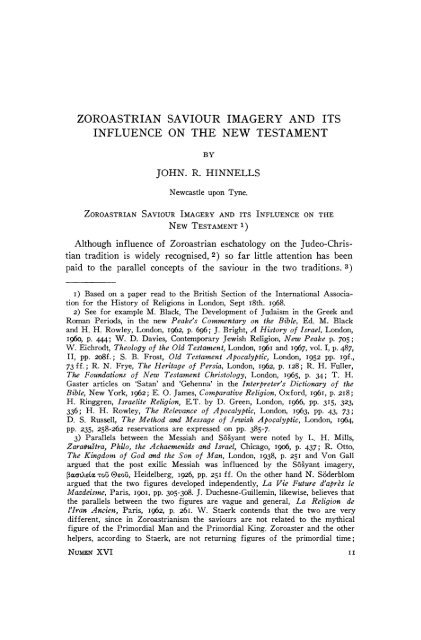Zoroastrian Saviour Imagery and Its Influence on ... - Kaveh Farrokh
Zoroastrian Saviour Imagery and Its Influence on ... - Kaveh Farrokh
Zoroastrian Saviour Imagery and Its Influence on ... - Kaveh Farrokh
You also want an ePaper? Increase the reach of your titles
YUMPU automatically turns print PDFs into web optimized ePapers that Google loves.
ZOROASTRIAN SAVIOUR IMAGERY AND ITS<br />
INFLUENCE ON THE NEW TESTAMENT<br />
BY<br />
JOHN. R. HINNELLS<br />
Newcastle up<strong>on</strong> Tyne.<br />
ZOROASTRIAN SAVIOUR IMAGERY AND ITS INFLUENCE ON THE<br />
NEW TESTAMENT 1)<br />
Although influence of <str<strong>on</strong>g>Zoroastrian</str<strong>on</strong>g> eschatology <strong>on</strong> the Judeo-Chris-<br />
tian traditi<strong>on</strong> is widely recognised, 2) so far little attenti<strong>on</strong> has been<br />
paid to the parallel c<strong>on</strong>cepts of the saviour in the two traditi<strong>on</strong>s. 3)<br />
I) Based <strong>on</strong> a paper read to the British Secti<strong>on</strong> of the Internati<strong>on</strong>al Associati<strong>on</strong><br />
for the History of Religi<strong>on</strong>s in L<strong>on</strong>d<strong>on</strong>, Sept I8th. I968.<br />
2) See for example M. Black, The Development of Judaism in the Greek <str<strong>on</strong>g>and</str<strong>on</strong>g><br />
Roman Periods, in the new Peake's Commentary <strong>on</strong> the Bible, Ed. M. Black<br />
<str<strong>on</strong>g>and</str<strong>on</strong>g> H. H. Rowley, L<strong>on</strong>d<strong>on</strong>, I962, p. 696; J. Bright, A History of Israel, L<strong>on</strong>d<strong>on</strong>,<br />
I96o, p. 444; W. D. Davies, C<strong>on</strong>temporary Jewish Religi<strong>on</strong>, New Peake p. 705;<br />
W. Eichrodt, Theology of the Old Testament, L<strong>on</strong>d<strong>on</strong>, 1961 <str<strong>on</strong>g>and</str<strong>on</strong>g> I967, vol. I, p. 487,<br />
II, pp. 2o8f.; S. B. Frost, Old Testament Apocalyptic, L<strong>on</strong>d<strong>on</strong>, 1952 pp. I9f.,<br />
73 ff.; R. N. Frye, The Heritage of Persia, L<strong>on</strong>d<strong>on</strong>, I962, p. 128; R. H. Fuller,<br />
The Foundati<strong>on</strong>s of New Testament Christology, L<strong>on</strong>d<strong>on</strong>, I965, p. 34; T. H.<br />
Gaster articles <strong>on</strong> 'Satan' <str<strong>on</strong>g>and</str<strong>on</strong>g> 'Gehenna' in the Interpreter's Dicti<strong>on</strong>ary of the<br />
Bible, New York, 1962; E. O. James, Comparative Religi<strong>on</strong>, Oxford, I96I, p. 218;<br />
H. Ringgren, Israelite Religi<strong>on</strong>, E.T. by D. Green, L<strong>on</strong>d<strong>on</strong>, 1966, pp. 315, 323,<br />
336; H. H. Rowley, The Relevance of Apocalyptic, L<strong>on</strong>d<strong>on</strong>, I963, pp. 43, 73;<br />
D. S. Russell, The Method <str<strong>on</strong>g>and</str<strong>on</strong>g> Message of Jewish Apocalyptic, L<strong>on</strong>d<strong>on</strong>, I964,<br />
pp. 235, 258-262 reservati<strong>on</strong>s are expressed <strong>on</strong> pp. 385-7.<br />
3) Parallels between the Messiah <str<strong>on</strong>g>and</str<strong>on</strong>g> S6oyant were noted by L. H. Mills,<br />
ZaraOustra, Philo, the Achaemenids <str<strong>on</strong>g>and</str<strong>on</strong>g> Israel, Chicago, 1906, p. 437; R. Otto,<br />
The Kingdom of God <str<strong>on</strong>g>and</str<strong>on</strong>g> the S<strong>on</strong> of Man, L<strong>on</strong>d<strong>on</strong>, 1938, p. 251 <str<strong>on</strong>g>and</str<strong>on</strong>g> V<strong>on</strong> Gall<br />
argued that the post exilic Messiah was influenced by the S6oyant imagery,<br />
paoaLXg) aro ??eo, Heidelberg, 1926, pp. 251 ff. On the other h<str<strong>on</strong>g>and</str<strong>on</strong>g> N. Siderblom<br />
argued that the two figures developed independently, La Vie Future d'apres le<br />
Mazdeisme, Paris, 190I, pp. 305-308. J. Duchesne-Guillemin, likewise, believes that<br />
the parallels between the two figures are vague <str<strong>on</strong>g>and</str<strong>on</strong>g> general, La Religi<strong>on</strong> de<br />
rIran Ancien, Paris, 1962, p. 261. W. Staerk c<strong>on</strong>tends that the two are very<br />
different, since in <str<strong>on</strong>g>Zoroastrian</str<strong>on</strong>g>ism the saviours are not related to the mythical<br />
figure of the Primordial Man <str<strong>on</strong>g>and</str<strong>on</strong>g> the Primordial King. Zoroaster <str<strong>on</strong>g>and</str<strong>on</strong>g> the other<br />
helpers, according to Staerk, are not returning figures of the primordial time;<br />
NUMEN XVI II
















